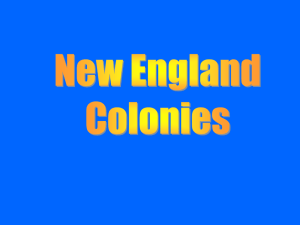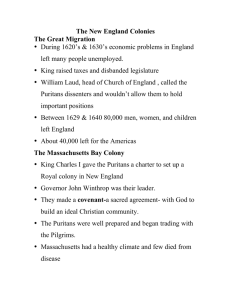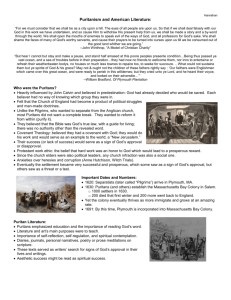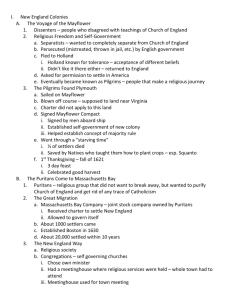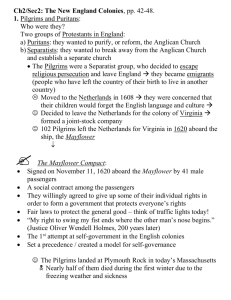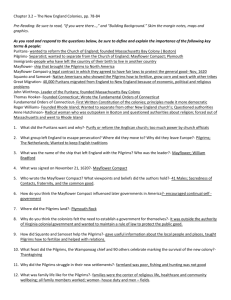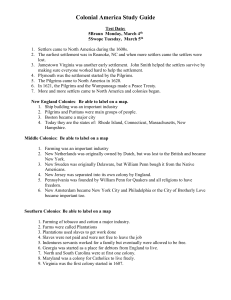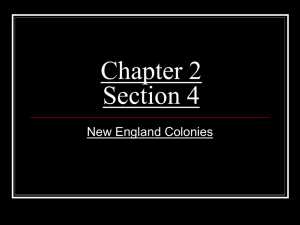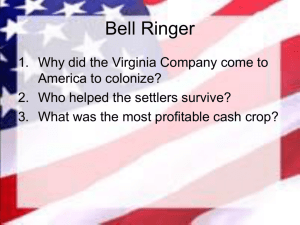The New England Colonies - Mater Academy Lakes High School
advertisement
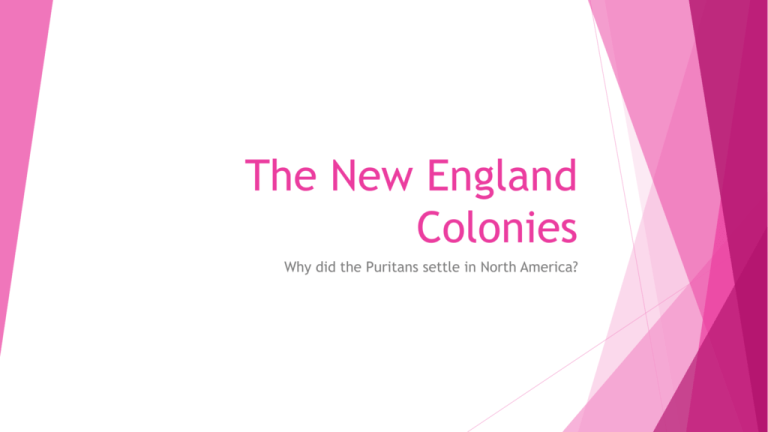
The New England Colonies Why did the Puritans settle in North America? Massachusetts (Much larger than present day) New Hampshire Rhode Island Connecticut Seeking Religious Freedom The Jamestown settlers had come to America in search of wealth. • The New England colonists arrived in search of religious freedom. England had been a Protestant country since 1534, when the king, Henry VIII, broke away from the Roman Catholic Church and formed the Anglican Church. • Not everyone in England was happy with the new church. • dissented, disagreeing with Anglican beliefs or practices. • Some English remained Catholic. • Others were Protestants who wanted to reform the Anglican Church. • others wanted to break away from it altogether. The Protestants who wished to reform the Anglican Church were called Puritans. Those who sought to set up their own churches were known as Separatists. • were persecuted-mistreated because of their beliefs—in England. • Many fled to find freedom to practice their religion The Pilgrims Settle Plymouth In 1620 a group of Separatists decided to move to America. They became known as the Pilgrims. • A pilgrim is someone who undertakes a religious journey. • The Pilgrims were able to get grants of land from the Virginia Company. • They got permission to settle in Virginia and to practice their religion freely. • ship called the Mayflower • • • • • The Mayflower drifted off course on its journey across the Atlantic. Lands in Cape Cod November colonists decided to drop anchor in Cape Cod Bay. Arrived in a place they called Plymouth. The Mayflower Compact Plymouth was outside the territory of the Virginia Company and its laws. • While still onboard ship, the Pilgrims signed a document they called the Mayflower Compact. • document set up an organized, orderly government. • Each signer promised to obey the laws passed “for the general good of the colony." The Mayflower Compact was a key step in the development of representative, democratic government in America. Native American Help During their first winter in America, almost half the Pilgrims died. • Illness, hunger, and cold • Two Native Americans, Squanto and Samoset, befriended the colonists. • taught the Pilgrims to grow corn, beans, and pumpkins • showed the colonists where to hunt and fish. • Squanto and Samoset also helped the Pilgrims make peace with the Wampanoag people who lived in the area. • In the fall of 1621, the Pilgrims included their new Wampanoag friends in a feast of thanksgiving. Plymouth Connecticut In 1629 a group of Puritans formed the Massachusetts Bay Company. • received a royal charter to establish a colony north of Plymouth. • company chose John Winthrop to be the colony's governor. • In 1630 Winthrop led about 900 men, women, and children to Massachusetts Bay. • Most of them settled in a place they called Boston. (Current Capital of Massachusetts). More settlers followed. • During the 1630s, more than 15,000 Puritans journeyed to Massachusetts to escape religious persecution and economic hard times in England. This movement of people (for religious freedom) became known as the Great Migration. Rhode Island A minister named Roger Williams founded the colony of Rhode Island. • Williams felt that government should not force people to worship in a certain way. • also believed it was wrong for settlers to take land away from the Native Americans. • Forced by Massachusetts leaders to leave the colony, Williams found refuge with the Narragansett, a Native American people (in present day Rhode Island). • They later sold him land, where Williams founded the town of Providence.(Current capital of Rhode Island). • With its policy of religious toleration, Rhode Island became a safe place for dissenters. • It was the first place in America where people of all faiths could worship freely. New Hampshire In 1638 John Wheelwright led a group of dissidents from Massachusetts to found the town of Exeter in New Hampshire. • New Hampshire became an independent colony in 1679. Conflict with Native Americans As settlers spread across New England, they met the Native Americans who lived there. • Native Americans traded furs for settlers' goods, but conflicts arose. • Usually settlers moved onto Native American lands without permission or payment. • Throughout the colonial period, settlers and Native Americans competed fiercely for land. At first Winthrop and his assistants made the colony's laws. • In 1634 settlers demanded a larger role in the government. • Adult male church members were allowed to vote for the governor and for representatives to the government. • Later, property ownership became a requirement for voting (while still being male). Ironically - The Puritans came to America to put their religious beliefs into practice. • At the same time, they themselves had little tolerance for different beliefs. • criticized or persecuted people who did not agree with their views. • strictly enforced their own religious rules. This lack of tolerance led people to form new colonies. Connecticut and Rhode Island To the west of Boston is land we now call the Connecticut River Valley. • land is better for farming than the stony soil around Boston. • In the 1630s colonists began to settle this area. A leader of this movement was Massachusetts minister Thomas Hooker. • did not like how Winthrop and other Puritan leaders ran the colony. • In 1636 Hooker led his congregation to the Connecticut River Valley. • founded the town of Hartford. (Current capital of Connecticut). • Other nearby towns were soon established. • Three years later these towns formed a colony called Connecticut. In • • • 1639 they adopted a plan of government called the Fundamental Orders of Connecticut. first written constitution in America. (Connecticut is known as the constitution state.) document described the organization of representative government in detail. belief in democratic principles.
